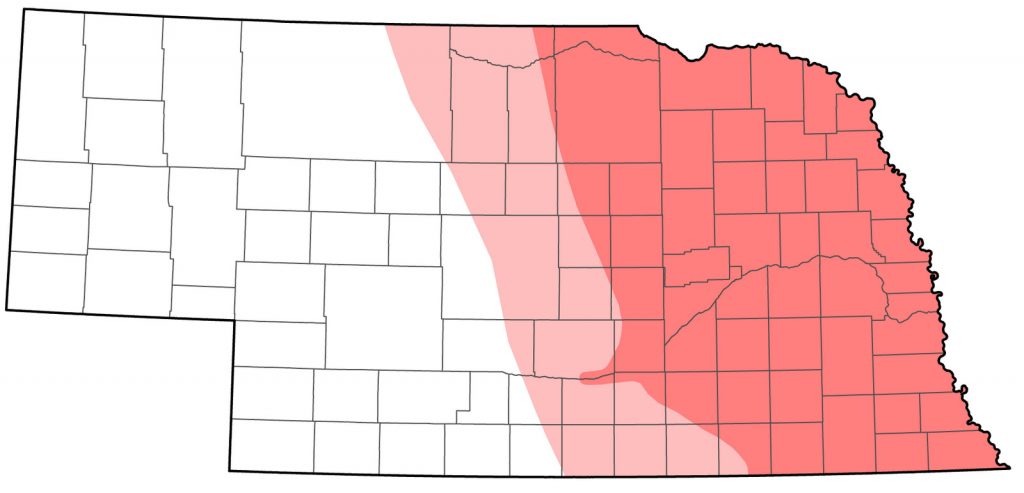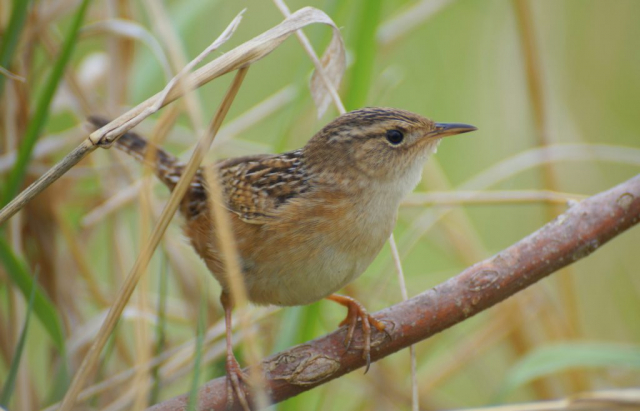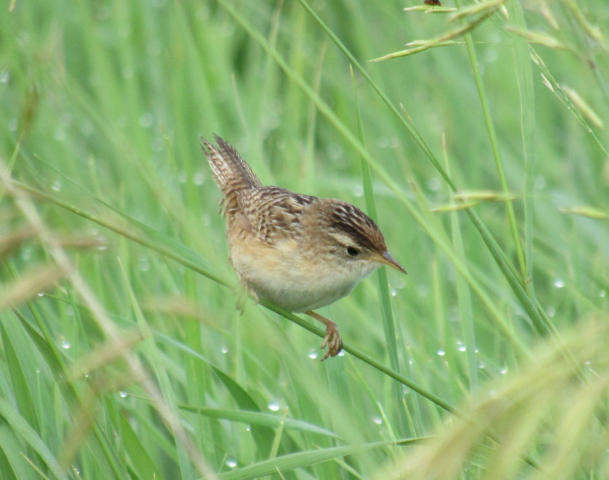Cistothorus stellaris
Status: Uncommon regular spring and fall migrant east and east-central, rare casual west-central and Panhandle. Rare regular breeder east and east-central (May-Jun; “early peak”). Uncommon regular breeder east and east-central (Jul-Aug; “late peak”). Accidental in winter.

Documentation: Specimen: UNSM ZM6605, 28 Aug 1902 Lancaster Co.
Taxonomy: Former Sedge Wren C. platensis consisted of 18 subspecies, but the North American taxon stellaris differs from all other taxa within former C. platensis in being polygynous, migratory, non-site specific, and having an improvised song, leading to its elevation to specific status as monotypic C. stellaris Sedge Wren (Robbins and Nyari 2014, Chesser et al 2021).
No subspecies are recognized (AviList 2025).
Changes Since 2000: Nesting in May-Jun in Nebraska was essentially unknown until about 2000, when such reports started to increase dramatically. Previously, breeding Sedge Wrens were not present until mid-Jul (see Summer).
Spring: Apr 18, 20, 21 <<<>>> summer
There is a well-defined movement in Apr and May; reports into early Jun may be late migrants or birds attempting to breed.
Reports west of the mapped range are few: 20 April 1957 Thomas Co, 9 May 1997 Ackley Valley Marsh, Keith Co (Brown and Brown 2001), 18 May 2019 Lincoln Co, 21 May 2023 Cottonwood SRA, Cherry Co, 7 Jun 2016 Sheridan Co, 18 Jun 2025 Mullen, Hooker Co, and 21 Jun 2025 Hiatt Wetlands, Lincoln Co. It was listed as an “uncommon migrant/summer resident” in Thomas Co (Bray 1994).
- High counts: 38 at Flanagan Lake, Douglas Co 12 May 2024, 19 on 22 May 2000 at Boyer Chute NWR, Washington Co, and 14 at Flanagan Lake, Douglas Co 10 May 2022.
Summer: Jul 14, 14, 15 (“late peak” breeders) <<<>>> Nov 1, 1, 1
The Sedge Wren has one of the more complex and difficult to define breeding strategies amongst Nebraska’s birds. Its occurrence, understanding of which is based largely on the presence of singing males, has definable patterns from spring through early fall, but is variable and apparently evolving. There are two apparent peaks in numbers per breeding season in Nebraska (“early peak” and “late peak”), possibly involving different individuals and representing different populations. Both are restricted mostly to the eastern half of the state (Mollhoff 2016) but separated by breeding phenology; the first peak in numbers is typical of most migratory passerines breeding in the state, involving nesting in spring and early summer. The second peak in numbers occurs in mid-summer and includes birds arriving and possibly nesting during late summer. Regarding the latter influx, Robbins and Nyari (2014) stated “Unique [to the North American subspecies, stellaris] is the intra-breeding seasonal movement, presumed to be from north to south that results in double breeding” (see below). Interesting observations of the timing of the two seasons were made in 2022 at Flanagan Lake, Douglas Co, where early breeders were four pairs along the northeast part of the marsh through 26 Jun, while late season arrivals, six on 27 Jul, set up on the west side of the lake (Val Kollath, eBird.org). On 12 Jun 2025, 15 were present at Flanagan Lake.
Sedge Wren has rather exacting breeding habitat requirements, best-described as damp grassy or sedge meadows; Bedell (1996) described a preferred habitat type as “sub-irrigated native meadow”, although this habitat type is restricted essentially to the central Platte River Valley. In Nebraska, territorial birds are most often found in lush mid- and tall-grass prairie during summers with above-normal precipitation. Nests are well-hidden and low in dense vegetation over damp ground or mud or at most a little standing water. Such habitat is extremely sensitive to weather conditions, and it appears that this species has the ability to search out suitable habitat and breed as late as Aug if necessary.
Breeding during spring and early summer (the “early peak”) has been rare in Nebraska, with few confirmed records, but beginning around 2000, reports of Sedge Wrens in Jun have increased markedly, albeit without documentation of breeding. Between 2009 and 2018 there were around 30 reports of Sedge Wrens 23 May-11 Jul; in 2020 alone, there were at least 40 reports from seven locations in Dakota, Lancaster, Saunders, Douglas, and Gage Cos, and in 2021 up to five were at Flanagan Lake, Douglas Co through 1 Jul and up to four at Frank Shoemaker Marsh, Lancaster Co through 29 Jun. Nest building was under way at Flanagan Lake, Douglas Co 5-24 May 2024. Documented nesting records during this early peak period include a nest with five young in Thurston Co 24 Jun 1971 which was the first in Nebraska for at least 70 years (Cink 1973) since Wolcott (1902) noted nests at West Point and Lincoln prior to 1902. In addition, an adult was feeding young in Sarpy Co 6 Jul 2003 (Mollhoff 2005a). Two nests were found near Hastings, Adams Co 23 May 2009, possibly dummy nests as no eggs were present and no female was sighted with the 2-3 males (Paul Dunbar, personal communication).
Additional early peak breeding season reports without documented breeding include sightings Jun-Aug each year since 1999 but without evidence of nesting at Boyer Chute NWR (Jerry Toll, personal communication), grasslands in Hall Co had “nesting” birds late May through Jul 2005 (Mollhoff 2005b), and one was reported on River Road, Phelps Co 12 Jun 2017. Singing birds occupied meadows at Wehrspann Lake, Sarpy Co, for two months prior to 25 Aug 2006; no evidence for breeding was observed other than territorial behavior. Westernmost of these early breeding season reports are from Keya Paha and Garfield Cos 15-24 Jun 2011, eight calling birds in Holt Co 18 Jun 2016, two westerly near Nenzel, Cherry Co 8 Jun 2022 and two mid-Jun records from Valentine NWR, Cherry Co: 18 Jun 2005 and 25 Jun 2009. The only Jun-early Jul records for the eastern Rainwater Basin are of two singing males 18 Jun 2003 at County Line WPA (Jorgensen 2004), a single bird at Flatsedge WMA 24 Jun 2005, one at Troester WPA, Hamilton Co, 3 Jul, and three singing males in Thayer Co 3 Jul 2015.
In 2018 there were three reports of possible breeding birds, all in Lancaster Co at three different locations 11-16 Jun.
At one time, Sedge Wrens arriving from early Jul onwards were thought to be early fall migrants, but it is now understood that they represent a second breeding peak (“late peak”) following an intra-seasonal movement or migration, known as “intra-seasonal double breeding” (Robbins and Nyari 2014). Herkert et al (2020) remarked broadly about the species summer distribution in the Interior and stated that breeding occurs May-Sep, but that “breeding is concentrated in different portions of the range at different times of the season”. Nesting in May–Jun is mostly concentrated in north-central areas including Wisconsin, Minnesota, North Dakota, and Saskatchewan, but in the south and east, including Arkansas, Kansas, southern Illinois, Nebraska, and Missouri, nesting is frequently not initiated until Jul or Aug, or even Sep (Herkert et al 2020).
The phenomenon of intra-seasonal double breeding in Sedge Wrens has been well-studied in Nebraska (Lingle and Bedell 1989, Bedell 1996, Herkert et al 2020; see above). Bedell (1996) suggested that late summer breeding in Nebraska may involve bachelor males moving south from northern breeding areas in hopes that if conditions are unsuitable to the north then returning females may arrive and allow breeding with these bachelor males. It has been suggested (Joe Roller, personal communication) that migrants which pass through Nebraska northward in spring and are unsuccessful in locating suitable breeding habitat, or indeed successfully raise a first brood but mowing or other intrusions cause failure of a second brood, apparently return to Nebraska and breed in Jul and Aug (and even Sep in Kansas). According to Herkert et al (2020), these Jul-Aug nestings may represent re-nesting attempts by individuals arriving from elsewhere within their range, as suggested by Bedell (1996), or could be an adaptive response of local birds to delayed availability of moist but un-flooded grassland habitat, as suggested by Gibbs and Melvin (1992). Bedell’s (1996) hypothesis is possibly correct; coinciding with late midsummer arrival dates at many southerly breeding locations are (1) the late Jun-early Jul cessation of breeding at northern breeding areas such as Quebec; (2) beginning of departures from northern breeding areas such as northern Wisconsin (Temple and Carey 1987), and (3) a general shifting about in and out of nesting territories as reported in both Minnesota and Illinois (Herkert et al 2020).
Sedge Wrens are often numerous in suitable grasslands beginning in mid-Jul in the eastern half of Nebraska, but westerly reports are few: 12 Jul 2025 Cody Paek, Lincoln Co, 1-2 singing in wet meadow northwest of North Platte, Lincoln Co 6 Aug 2008, five at Valentine NWR 10 Aug 2012, four at Steer Creek Campground, Cherry Co 14 Aug 2022, and singles at Oliver Reservoir, Kimball Co 7 Sep 2015 and 5 Sep 2016. There are several records of nesting during the late peak period, especially at Mormon Island Crane Meadows in Hall Co. A nest with eggs was in Hall Co 26 Jul 1988 at a location where 123 wrens were present (Lingle and Bedell 1989, Grzybowski 1988, 1989), seven nests with eggs 10-28 Aug 1989 in Hall Co (Grzybowski 1990), nests with eggs 24 Aug and 1 Sep in Hall Co in the period 1984-89 (Mollhoff 2001, 2022), nests with eggs 29 Aug 1992 and 26 Aug 1994, the latter in Hamilton Co (Bedell; Mollhoff 2022), and eight nests with eggs in Hall Co 30 May- 28 Jul 2005 (S. Sullivan; Mollhoff 2022). A nest with young was found in Boone Co 28 Aug in the period 1984-89 (Mollhoff 2001). Territorial males and adults carrying food were found in a grass and sedge meadow near Clay Center, Clay Co 17 Jul 1971 (Cink 1973). Nest building by Sedge Wrens may not indicate breeding; dummy nests are common, such as those found north of Lincoln in Lancaster Co 8 Jul 1972 (Cink 1973), a bird carrying nest material in Otoe Co 22 Jul 2007, and reports during 1996 and 1997 of territorial males in lush mid- and tall-grass prairie habitat at Nine-mile Prairie, Lancaster Co; a nest was under construction there 14 Aug 2000.
- Breeding phenology:
Nest building: 5 May-14 Aug
Eggs: 30 May-1 Sep
Nestlings: 24 Jun-28 Aug
Fledglings: 6 Jul
Fall: summer <<<>>> Nov 1, 1, 1
Later dates are 3 Nov 2019 Lancaster Co, 4 Nov 2022 Sarpy Co, 9 Nov 2002 Dwight, Butler Co, 15 Nov 2011 Lancaster Co, 29 Oct-17 Nov 2015 Sarpy Co, a specimen, WSC 196, 17 Nov 2022 Antelope Co, 20 Nov 1976 Boone Co.
Migration apparently begins in mid-Jul where breeding did not occur; Jul arrivals are birds that often if not usually attempt nesting (see Summer). True fall migration (after nesting) in this species probably takes place in Sep-Oct.
The only Panhandle report is of one calling and calls described by an experienced observer along Road 44 in extreme southeastern Garden Co 7 Aug 2020 (Mlodinow, eBird.org). The only reports in the west-central are of singles in Keith Co 9 Aug 2018 and 16 Sep 2017, Grant Co 3 Sep 2023, Hayes Co 10 Oct 2020., and Keith Co 11 Oct 2024.
- High counts: 123 on 26 Jul 1988 in Hall Co (Lingle and Bedell 1989), 60 in the eastern Rainwater Basin 7 Aug 1999, and 60 there 7 Aug 1999.
Winter:
The only record is of one in Lancaster Co 4-5 Jan 2019, photographed 4 Jan. Previous latest date was 20 Nov.
Images
Abbreviations
NWR: National Wildlife Refuge
SP: State Park
SRA: State Recreation Area
UNSM: University of Nebraska State Museum
WMA: Wildlife Management Area (State)
WPA: Waterfowl Production Area (Federal)
WSC: Wayne State College
Literature Cited
AviList Core Team, 2025. AviList: The Global Avian Checklist, v2025. https://doi.org/10.2173/avilist.v2025.
Bedell, P.A. 1996. Evidence of dual breeding ranges for the Sedge Wren in the central Great Plains. Wilson Bulletin 108: 115-122.
Bray, T.E. 1994. Habitat utilization by birds in a man-made forest in the Nebraska Sandhills. Master’s thesis, University of Nebraska-Omaha, Omaha, Nebraska, USA.
Brown, C.R., and M.B. Brown. 2001. Birds of the Cedar Point Biological Station. Occasional Papers of the Cedar Point Biological Station, No. 1.
Chesser, R.T., S.M. Billerman, K.J. Burns, C. Cicero, J.L. Dunn, B.E. Hernández-Baños, A.W. Kratter, I.J.Lovette, N.A. Mason, P.C. Rasmussen, J.V. Remsen, Jr., D.F. Stotz, and K. Winker. 2021. Sixty-second Supplement to the American Ornithological Society’s Check-list of North American Birds. Ornithology 138, Issue 3, https://doi.org/10.1093/ornithology/ukab037.
Cink, C.L. 1973. Summer records of the Short-billed Marsh Wren in Nebraska. NBR 41: 17-19.
Gibbs, J.P., and S.M. Melvin. 1992. “Sedge Wren, Cistothorus platensis.” In Migratory nongame birds of management concern in the Northeast., edited by K. J. Schneider and D. M. Pence, 191-209. Newton Corner, MA: U.S. Department of Interior, Fish and Wildlife Service.
Grzybowski, J.A. 1988. Southern Great Plains Region. American Birds 42: 1308-1310.
Grzybowski, J.A. 1989. Southern Great Plains Region. American Birds 43: 124-126.
Grzybowski, J.A. 1990. Southern Great Plains Region. American Birds 44: 114-117.
Herkert, J.R., D.E. Kroodsma, and J.P. Gibbs. 2020. Sedge Wren (Cistothorus platensis), version 1.0. In Birds of the World (A. F. Poole and F. B. Gill, Editors). Cornell Lab of Ornithology, Ithaca, NY, USA. https://doi.org/10.2173/bow.sedwre.01.
Jorgensen, J.G. 2004. A preliminary assessment of eastern Rainwater Basin birdlife. Published by the author, Blair, Nebraska, USA.
Lingle, G.R., and P.A. Bedell. 1989. Nesting ecology of Sedge Wrens in Hall County, Nebraska. NBR 57: 47-49.
Mollhoff, W.J. 2001. The Nebraska Breeding Bird Atlas 1984-1989. Nebraska Ornithologists’ Union Occasional Papers No. 7. Nebraska Game and Parks Commission, Lincoln, Nebraska, USA.
Mollhoff, W.J. 2005a. The 2003-2004 Nebraska nest report. NBR 73: 15-19.
Mollhoff, W.J. 2005b. The 2005 Nebraska nest report. NBR 73: 119-123.
Mollhoff, W.J. 2016. The Second Nebraska Breeding Bird Atlas. Bull. Univ. Nebraska State Museum Vol 29. University of Nebraska State Museum, Lincoln, Nebraska, USA.
Mollhoff, W.J. 2022. Nest records of Nebraska birds. Nebraska Ornithologists’ Union Occasional Paper Number 9.
Robbins, M.B., and A.S. Nyari. 2014. Canada to Tierra del Fuego: species limits and historical biogeography of the Sedge Wren (Cistothorus platensis). Wilson Journal of Ornithology 126: 649-662.
Temple, S.A. and J.R. Carey. 1987. Wisconsin birds: a seasonal and geographic guide. University of Wisconsin Press, Madison, Wisconsin, USA.
Wolcott, R.H. 1902. Short-billed Marsh Wren and Carolina Wren at Lincoln. Proceedings Nebraska Ornithologists’ Union 3: 108.
Recommended Citation
Silcock, W.R., and J.G. Jorgensen. 2025. Sedge Wren (Cistothorus stellaris). In Birds of Nebraska — Online. www.BirdsofNebraska.org
Birds of Nebraska – Online
Updated 27 Aug 2025


